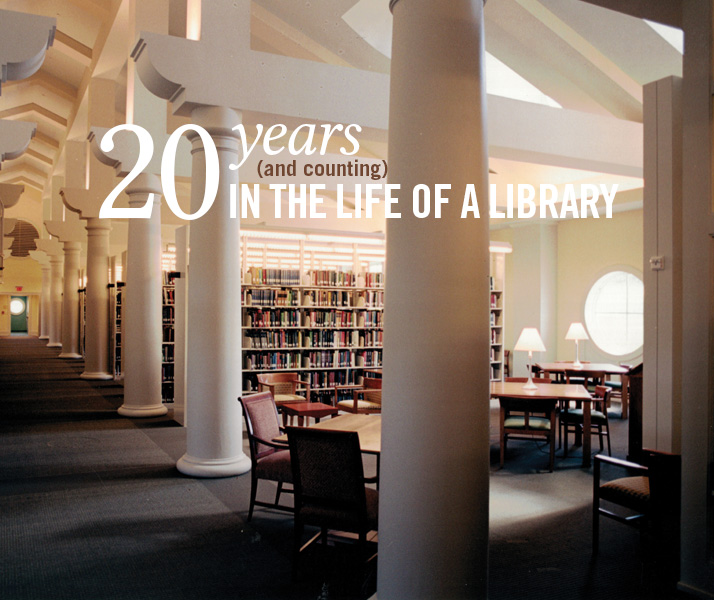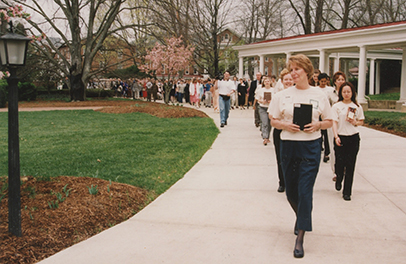
Twenty Years (and Counting) in the Life of a Library
Twenty years after the Wyndham Robertson Library opened, its signature elements remain—but changes in services and in space, both physical and digital, address the evolving needs of the campus community.
By Luke Vilelle, Maryke Barber, and Rebecca Seipp
New spaces and services
The library’s stately columns, light-filled spaces, dedication to the printed word, and Hollins Authors collection all remain signature elements in 2019, 20 years after the building’s grand opening.
But over those years, subtle and not-so-subtle changes have been made, in response to community needs, that have elevated the library’s spaces and collections.
Most prominent is the 2015 first-floor addition of the R. Lowell Wine Center for Learning Excellence (CLE), home to the Writing Center and Quantitative Reasoning Center. The CLE firmly establishes the library as the go-to building for student support. Included in the CLE is a flexible and tech-infused classroom, critical to the burgeoning instruction needs of the library. Librarians teach more than 100 research and information literacy sessions each academic year, more than five times as many as they did in 1999.
Near the CLE on the first floor, you will find a revamped reading room. The periodical shelves included in the original construction were no longer needed, because of the migration of journal content online, but the space remains true to its original design with the 2014 installation of armchairs and couches that invite community members into the space. The evening coffee shop, which opened in 2015 in the Norfolk Southern Coffee Commons, provides additional motivation to students to plant themselves in the library for studying and reading.
As you travel deeper into the library, you might note many smaller improvements, such as:
- Two “living room” spaces in library corners, featuring sofas and comfortable seating, to accommodate our students’ wish for a variety of seating options
- Table-top lamps with charging stations, for powering up student mobile devices
- Whiteboards in many group study spaces, which you may find filled with formulas, poetry, or simple encouragement for the next students to use the space
What you don’t see, however, may be the biggest change to the library. In 2014, the library debuted its institutional repository, the Hollins Digital Commons, and has since extended its digital initiatives to include other platforms that support digital teaching and learning. These projects preserve, promote, and provide open access to the intellectual and creative output of the Hollins University community. With these resources, you can be transported virtually to the Wyndham Robertson Library from any place and at any time.
Luke Vilelle, university librarian
Visit the Digital Commons: http://library.hollins.edu/digital-projects.

Jan Thompson ’99 led the procession to the new library in spring 1999. The group carried 15 works by Hollins authors, including books, a musical score, a videotape, and a journal article.
Library book club
Much of the programming on campus focuses on the needs of students. The library wanted to do something specifically for staff, and started the book club in the fall of 2008 with a discussion of Annie Dillard’s [’67, M.A. ’68] The May Trees. Over the years, faculty and alumunae/i were invited to the table; to our knowledge, this is the only recurring program in which these three groups get to come together in intellectual discussion. To accommodate staff schedules, the group meets at lunchtime; it is a real pleasure to have a break in the day for contemplating the merits (or shortcomings) of a great read. We meet in the beautiful Hollins Room and enjoy coffee and dessert, occasionally baked by the library staff.
Our readings range broadly from literary fiction to biography and back again. There are so many great opportunities for inspiration at a university: books by alums, books by speakers and other visitors, the first-year readings, the selection for Roanoke Valley Reads, or whatever fires the imaginations of the group. Occasionally a theme is chosen and the group votes on selections that are all comedies, or works in translation, or classic plays, or another genre of interest. Some theme suggestions are more challenging than others: I think one which gave me the most pause was “let’s read something funny by a Southern author!” This sounded perfectly reasonable until I started searching and realized just how much of Great Southern Literature is drama, if not downright gothic. But there’s always a solution: In this case, we had a great time reading Eudora Welty’s The Optimist’s Daughter.
Here’s a list of what I consider our most interesting/popular reads:
Aeschylus: Agamemnon; Sophocles: Antigone; and Euripides: Medea
Frederick Backman: Beartown
Charlotte Brontë: Villette
Paul Harding: Tinkers
Paul Kalanithi: When Breath Becomes Air
Beth Macy M.A. ’93: Dopesick
Wangari Maathai: Unbowed: A Memoir
Jose Saramago: Death with Interruptions
David Wroblewski: The Story of Edgar Sawtelle
Local alumnae/i are welcome to join our mailing list. Contact mbarber@hollins.edu for more details.
Maryke Barber, public services/liaison librarian
Fixing Wikipedia’s gender bias
Wikipedia’s gender trouble is well documented. In a 2011 survey, the Wikimedia Foundation found that less than 10 percent of its contributors were women. While the reasons for the gender gap are up for debate, the practical effect of this disparity is not: Content is skewed by the lack of representation from women. In 2014 the first national Art+Feminism Wikipedia Edit-a-thon was held to help correct this bias.
In 2018 the Wyndham Robertson Library partnered with the Wilson Museum to participate in our first Art+Feminism Wikipedia Edit-a-thon. Hollins’ rich artistic history provided us with a wonderful opportunity to create a specific focus for our spring 2018 event: updating and creating pages for artists associated with the university as faculty, alumnae/i, or artists-in-residence. The following semester, Public Services Librarian Maryke Barber partnered with Assistant Professor of Art Genevieve Hendricks to bring Wikipedia editing to her first-year seminar, which was focused on women in architecture. As part of their course assignment, students searched for reliable sources; they added new information and enhanced the references for existing articles; one student even created an entirely new article. In spring 2019, the library hosted a second public edit-a-thon where students and members of the Hollins community could stop by to learn more about Wikipedia and begin editing.
Why Wikipedia and why the Wyndham Robertson Library? Aside from the obvious connection of a women’s university wanting to help address gender bias on one of the most visited sites on the internet, Wikipedia is ripe with opportunity for discussion about knowledge creation in the 21st century. What makes a credible source? Who creates this information? How do you determine authority? These are questions that every beginning scholar grapples with, and they can be explored through Wikipedia using this hands-on experience that immerses participants in creating and learning.
Rebecca Seipp, outreach/liaison librarian
For more information about edit-a-thons from the Art+Feminism organization: www.artandfeminism.org/organizing-kit.
Photos by: Richard Boyd

